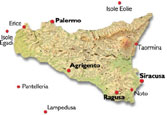 |
 |
|
Aidone & Morgantina (EN) | ||
|
||||||||
|
There can be few bleaker and lonelier places than Morgantina on a cold and misty December day. Which is unfair: Morgantina has a good claim to be Sicily's Pompeii - although its demise was due to man's desertion of the site rather than wild nature. On the day of my visit it was deserted, apart from a few dogs, and some men collecting escarole. It was only identified as Morgantina in 1957, and still little more than a fifth has been excavated by the archaeological team from Princeton. It had ceased to exist as a city 2000 years previously - it was already just a name by Strabo's day (1st century BC), although it's now known that Morgantina's history stretched back nearly a millennium before that.
The site is a piece of flat ground between two hills - given a 7km circuit of walls by Timoleon. There's a spacious agora with stoas on three sides, a tiny theatre, a fountain, a granary, a "pnyx" (ecclesiasterion - probably) and a prytaneion. There are houses from the Hellenistic period, many with mosaics. Finds from Morgantina are on show in a little museum in the rather grim town of Aidone, about 5 km away; it was completely deserted on the day I visited in late December 1993; there was no sign of life apart from an eerie knocking sound from the roof area. It's tucked away at the top of the town, in an old church. It's a delightful drive between Aidone and Piazza Armerina, through pine and eucalyptus forest. Postscript 2012
Whoever she is (and possibly only the local shepherds who found her could give us the clues) she's an extremely fine example of 5th century BC classical Greek sculpture - whith wind-blown drapery suggesting the influenceof Pheidias himself. But do the head and body belong together? But the Aidone's era of obscurity is over, that much is certain!
|
 |
Use the table below to find your way around Sicily: |  |
||||||||||
| Map | Index | PA | ME | CT | EN | CL | SR | RG | AG | TP | ||
Printer friendly page: click to print
| What's new? | Search the site? | Main Index? | Bookshop? | Top of Page? | ||||
|
The Classics Pages are written and designed
by Comments, questions and contributions welcome. |
||||||||